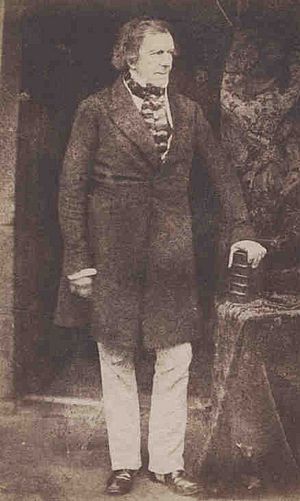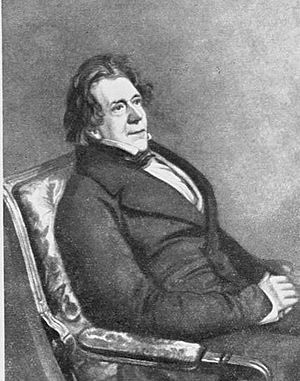Sir Philip Crampton, 1st Baronet facts for kids
Quick facts for kids
Sir Philip Crampton, 1st Baronet
|
|
|---|---|
 |
|
| Born | 7 June 1777 |
| Died | 10 June 1858 (aged 81) |
| Relatives | Philip Cecil Crampton (cousin) |
| Medical career | |
| Institutions | Royal College of Surgeons in Ireland |
| Sub-specialties | Anatomy |
Sir Philip Crampton (born June 7, 1777 – died June 10, 1858) was a very important Irish surgeon and expert in anatomy. Anatomy is the study of the body's structure. He was also a Fellow of the Royal Society (FRS), which is a special honor for top scientists. Sir Philip was the President of the Royal College of Surgeons in Ireland (RCSI) four times: in 1811, 1820, 1844, and 1855.
Contents
Who Was Sir Philip Crampton?
Early Life and Education
Philip Crampton was born in Dublin, Ireland. His father was John Crampton and his mother was Anne Verner. As a child, he was friends with Theobald Wolfe Tone, a famous Irish leader.
Philip began his medical training by working with a surgeon named Solomon Richards. Soon after, he started studying at the RCSI School. He then joined the army as an assistant surgeon. In 1798, he became a surgeon at the Meath Hospital, even before he was fully qualified. He earned his medical degree (MD) from Glasgow University in 1800. By 1801, he was a full Member of the RCSI. He worked at the Meath Hospital for almost 60 years.
Teaching and Private Practice
A few years later, Philip also became an assistant surgeon at the Lock Hospital in Dublin. He also built a very busy private medical practice at his home. He teamed up with Peter Harkan to teach anatomy in private classes. This was the first private school for anatomy and surgery in Dublin.
Amazing Discoveries and Research
In 1805, Crampton wrote an important paper about a condition called Entropion. This is when the eyelid turns inward. His work on this topic was very interesting at the time.
In 1813, he made a big discovery about bird eyes. He found a special muscle that helps birds see things far away or up close. This muscle helps the lens of the eye adjust, like a telescope. This muscle was named the "musculus cramptonius" in his honor. Because of this discovery, he became a Fellow of the Royal Society (F.R.S.) in Ireland. His writings were later published in the Dublin Journal of Medical Science.
Helping Children and the Community
In 1821, Philip Crampton, along with Sir Henry Marsh and Dr. Charles Johnston, started a hospital for children. It was called the Institute for Sick Children and was located in Pitt Street (now Balfe Street). This was the first teaching hospital for children in Ireland or Great Britain. Its main goal was to help sick children in one of the poorest areas of Dublin, called The Liberties.
Philip later became the chief surgeon for the armed forces in Ireland. He also continued to work as a consulting surgeon at Dr Steevens' Hospital and the Dublin Lying-in Hospital. He was elected President of the Royal College of Surgeons in Ireland (RCSI) four times.
He also helped Lady Harriet Kavanagh and her son, Arthur MacMurrough Kavanagh. Arthur was born with very short limbs. Crampton designed a special mechanical wheelchair for Arthur. This helped Arthur live an active life, and he later became a Member of Parliament (MP). Philip Crampton was given the special title of baronet on March 14, 1839. This means he was given the title "Sir" and his family could inherit it.
Interests and Legacy
Sir Philip Crampton was always interested in animals and science. He played a big part in starting the Royal Zoological Society of Ireland and was its president many times. He was also a member of the Royal Irish Academy.
He passed away at his home in Dublin. He had two sons and four daughters with his wife, Selina Cannon. His eldest son, John, inherited his title.
The Crampton Memorial
A memorial for Sir Philip Crampton was built in Dublin in 1862. It was located where College Street, Pearse Street, and D'Olier Street meet. The memorial was designed by the sculptor John Kirk. It was quite unusual, with a bust (a sculpture of his head and shoulders) above a fountain. Metal leaves flowed down from the top.
People in the 1800s called it the "water-babe." Later, it was nicknamed the "cauliflower," "pineapple," or "artichoke" because of its shape. The monument slowly started to fall apart, so it was removed in 1959.
The famous writer James Joyce mentioned the monument in his novel Ulysses. In the book, a character named Leopold Bloom sees the monument and wonders, "Sir Philip Crampton's memorial fountain bust. Who was he?" Joyce also mentioned the sculpture in his novel A Portrait of the Artist as a Young Man. In that book, a character named Stephen Dedalus uses it to explain different types of art.



